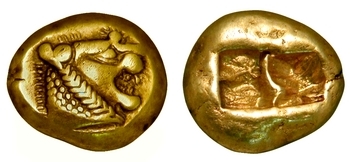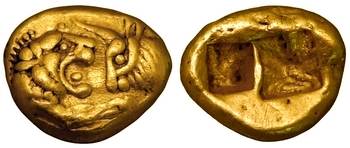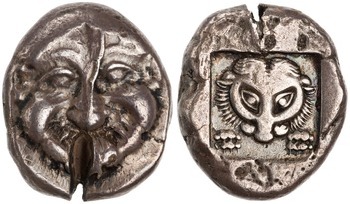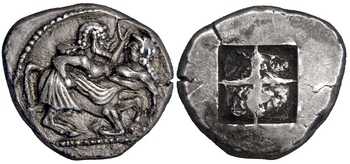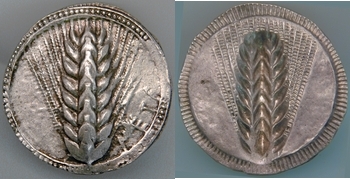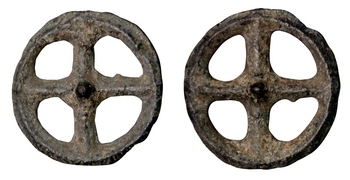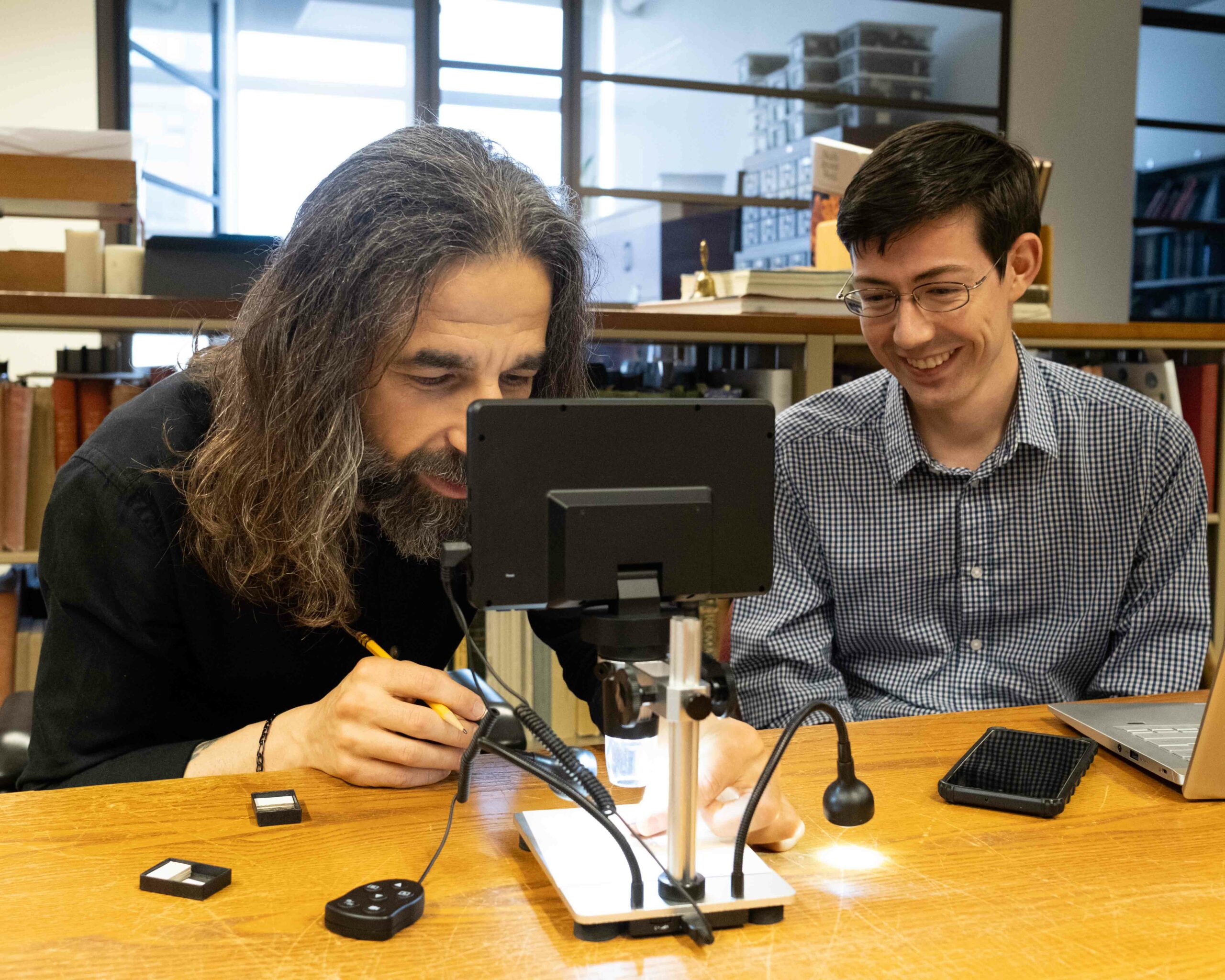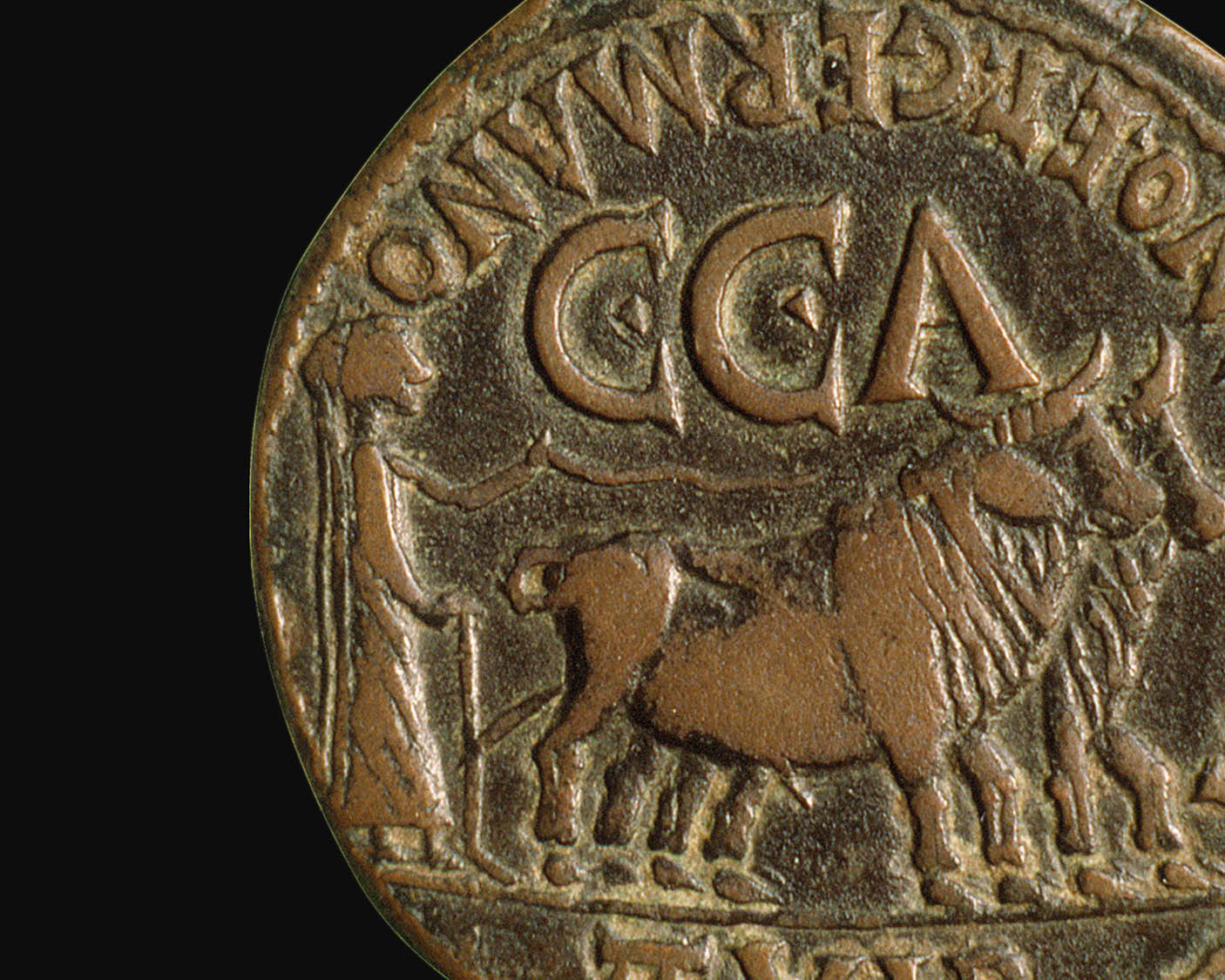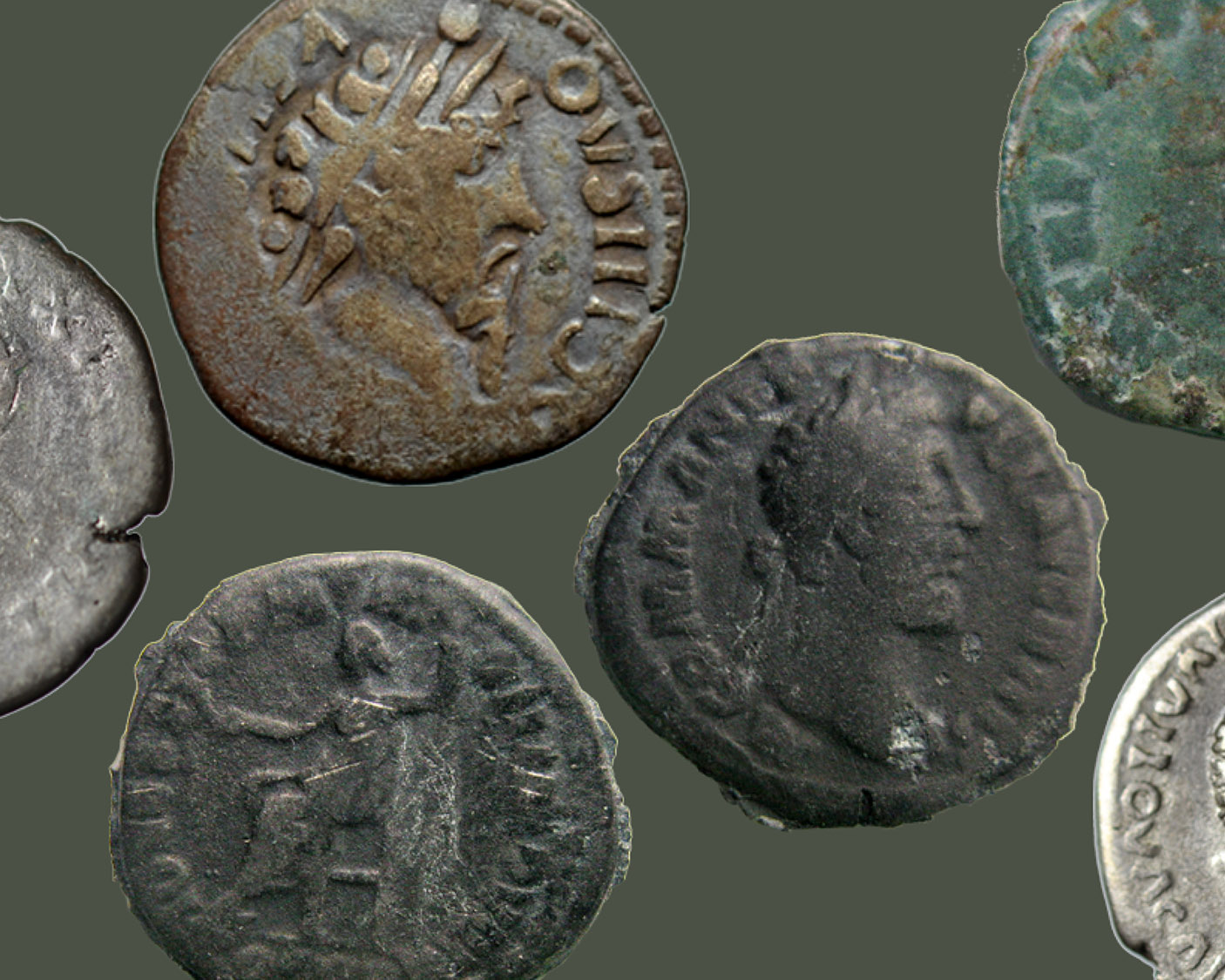Ancient Greece and the Mediterranean World
Exhibitions Home
Return to Drachmas, Dubloons, and Dollars homepage
The first coins were struck in 7th-century Lydia in Western Turkey. The new coins offered a convenient way to pay with pre-weighed pieces of metal, which were guaranteed by an authority. For centuries before this, people had been using cut-up silver bullion to conduct transactions, a practice that continued alongside bartering for many centuries. Due to the influence of Greek cities, coinage became a popular form of money that spread rapidly over the entire Mediterranean world and beyond.
For the first 300 years, coins were struck predominantly in silver, and the value of a coin was closely tied to its weight as bullion. In order to allow for smaller transactions, many Greek cities began to mint low-value bronze coins. Coins allowed people to facilitate long-distance trade and daily transactions, or simply to hoard savings. But despite a fairly well-developed coinage system, it is likely that most people in the ancient world, who lived in a largely agrarian society, did not use coins on a daily basis.
The design of Greek coins is important for the understanding of world coins of all periods. Many of the design features of coins, such as portraits or certain emblems, were first used on Greek coins. The engravers that created the dies for coins were sometimes outstanding artists, whose work survives in the miniature pieces of art.
Early Greek Coins
The first coins were made of electrum, an alloy of gold and silver that occurred naturally in local rivers. In the 6th century, Croesus, king of Lydia, began to strike coins of solid gold and silver. Soon afterwards, cities and rulers all over the Mediterranean world adopted coins for long-distance trade and local commerce.
Electrum 1/6 stater (7th century BC) struck with two square punches.
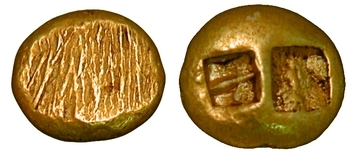
Lydian electrum 1/3 stater (mid 7th century BC) depicting a lion’s head, the badge of Lydian kings.
Lydian gold stater struck during the reign of King Croesus (561-546 BC), with the foreparts of a lion and a bull.
Silver tetradrachmon (c. 545 BC) of Athens with facing lion.
Silver tetradrachmon of the Orescii tribe in Thrace with a man-headed bull carrying off a nymph. Both were followers of Dionysos, the god of wine—an important product of the region.
Experimentation With Coinage
Some cities and kings continued to experiment with different forms of coin manufacture into the 5th century BC and beyond. Such coins often came from areas in the Balkans or mainland Europe.
Silver stater (550-470 BC) struck by the city of Metapontum depicting an ear of wheat on both sides of the coin in repoussé technique.
Bronze arrowhead money (5th century BC) produced by the city of Olbia (modern Ukraine). It was not uncommon for money to be produced in the form of stylized tools or weapons.
Bronze dolphin money of Olbia (5th century BC).
Celtic tin wheel money (c. 100 BC) from the region of modern Switzerland.
Coinage and Trade
Large silver or gold coins were used in long-distance trade, where they provided a convenient way of paying for expensive or large quantities of goods. The coins were usually made of pure silver according to a weight standard. The designs were often deliberately simple and conservative so that users all over the Greek world and beyond would recognize them immediately.
Silver stater (550-465 BC) of the island city of Aegina depicting a turtle. Aeginetan “turtles” became the dominant trade coins in southern Greece and the islands in the 6th and early 5th centuries BC.
Silver stater (415-387 BC) of Corinth depicting the winged horse Pegasus. These staters were important for conducting trade with Corinthian colonies in Sicily and along the Adriatic coast.
Gold stater (370-350 BC) of Panticapaeum depicting a griffon standing on an ear of wheat. Panticapaeum, a Greek colony located in modern Ukraine, was one of the main breadbaskets of the Greek world.
Silver tetradrachmon (435-375 BC) of Cyrene with silphium. This plant, famous for its medicinal and culinary properties, was a major export of Cyrene in Libya.
Oktadrachmon of the Derrones (480-470 BC). This tribe in the Balkans produced large bullion coins, which are frequently found in the Near East. The rough design shows a man in a chariot drawn by oxen.
Athenian Coinage
Athens occupied a particularly important role in the history of Greek coinage. In the 5th century, the Athenians built an empire with allies that paid tribute to them annually. The silver mines at nearby Laurion also allowed the city to mint whenever coins were necessary.
Silver tetradrachmon (5th century BC) of Athens depicting Athena, minted at the height of the Athenian Empire. Tetradrachms, unchanged for almost two centuries, were used as far away as Afghanistan.
Silver dekadrachmon (470-460 BC) of Athens showing a facing owl. This unusually heavy coin was probably made for trade with the Near East where most specimens have been found.
Electrum stater of Cyzicus (late 5th century BC), with a head of Zeus Ammon. Wealthy Athenians kept staters as savings or used them to pay for expensive items.
Everyday Coinage
Not all coins were large and valuable. From the beginning, tiny silver coins were issued by cities to pay their citizens for jury service or various military activities. By the 4th century, small silver coins were replaced by larger bronze coins that soon became the most common form of coinage in daily use.
Silver obol of Aradus in Phoenicia (390-370 BC).
Silver tetradrachmon of Sinope, struck a second time with a small stamp bearing a head, presumably as a re-issue.
Bronze coin of Syracuse with bull and dolphin (4th century BC).
Bronze coin of Ptolemy VIII Euergetes II of Egypt (146-116 BC). Egypt’s closed currency system included a variety of coins, such as this large bronze piece.
Black Attic vase with hoard of Athenian small change, found in Attica in the 1930s. In antiquity, savings were often buried in ceramic containers.
Coinage and War
In the ancient Greek world war was common. Money was often a motivating factor for military expeditions. Coins were needed to pay soldiers, and soldiers in turn would seize foreign treasures from which money was struck again. In some cases, the coins themselves chronicle the military successes and failures of the issuing authority. Although often made in times of crisis, some of these coins represent pieces of great art.
Persian gold daric (c. 5th century BC), showing the armed Persian king. Darics were some of the most popular coins used for hiring mercenary soldiers.
Egyptian gold daric (c. 359-343 BC) showing a hieroglyphic sign of a heart, lungs and windpipe. This rare issue was made to pay foreign Greek mercenaries to fight against the Persians.
Gold stater (c. 296-294 BC) of Athens. As a last resort in a crisis, citizens could go to their temples to find metal for coins. This coin was made from gold stripped from the famous statue of Athena in the Parthenon to pay for the defense of the city against a Macedonian army.
Siculo-Punic silver stater (270-260 BC) depicting Pegasus, struck by a Carthaginian military mint operating in Sicily.
Sicilian silver dekadrachmon (405-401 BC) of Syracuse with the nymph Arethusa, made from silver captured from the city’s enemies in North Africa and Sicily.
Alexander the Great
In 336 BC, at the age of 20, Alexander the Great became king of Macedonia. Within eight years he and his army defeated the mighty Persians and controlled an empire spanning from Greece to India. The victorious armies brought back to Greece enormous amounts of silver and booty. Alexander died in 323 BC while still a young man.
Silver tetradrachmon of Alexander (336-323 BC) depicting Herakles, his supposed ancestor.
Silver dekadrachmon of Alexander from Babylon (c. 323 BC) made from silver bullion taken from Persian treasuries.
Silver 5-shekel piece (326 BC) depicting Alexander in battle with an Indian rajah on an elephant.
Gold distater of Alexander with the head of Athena (330-320 BC).
Alexander-type silver tetradrachmon (201-190 BC). Struck by Rhodes.
Silver tetradrachmon (220-200 BC) of Abyatha, an Arabian king, imitating Alexander’s trade coinage.
Hellenistic Portrait Coins
After the death of Alexander the Great, his empire was divided among his generals and turned into several independent kingdoms. The rise of kings in this period is reflected on coins, which often bear the portrait of the monarch. Under the various dynasties, the arts were promoted and royal portraits became a common feature of coinage.
Silver tetradrachmon (287-282 BC) of Lysimachus (323-281 BC) depicting Alexander the Great.
Gold pentadrachmon of Ptolemy I Soter (305-283 BC) of Egypt.
Silver dekadrachmon of Ptolemy II Philopator (282-246 BC) portraying his wife, Arsinoe II.
AccNum: 1974.26.801
Silver tetradrachmon (c. 280 BC) of Philetaerus (c. 343-263 BC) portraying Seleucus I Nicator.
Silver tetradrachmon of Eucratides I (170-145 BC) from Bactria (Afghanistan).
Silver tetradrachmon of Mithradates VI of Pontus (120-63 BC) with wind-tossed hair reminiscent of portraits of Alexander.
Return to Drachmas, Dubloons, and Dollars homepage
Other pages of the exhibit:
[posts_grid columns=”4″ rows=”6″ order_by=”date” order=”ASC” meta=”no” link=”yes” category=”DrachmasDubloonsDollars”]


